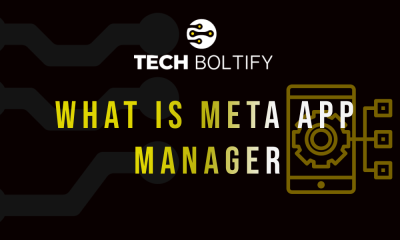Tech
Mastering Modern ORM in .NET: Boosting Code Efficiency, Safety, and Performance
Modern ORM features in .NET go far beyond simple object-to-table mapping; they offer powerful abstraction layers that help you write cleaner, safer, and faster code.
As backend systems grow more complex, the ability to fine-tune data access with tools like performance tuning, lazy/eager loading, and change tracking becomes a must. These features are not just nice-to-haves—they’re essential for building robust applications that can handle growth without becoming a maintenance nightmare.
With the evolution of ORM tools, developers now get streamlined workflows, enhanced productivity, and deeper integration with developer tools in Visual Studio and beyond. This means fewer bugs, better team collaboration, and a more predictable codebase.
ORMs in .NET today are not just utilities—they’re core architectural elements. Whether you’re building a microservice or a large-scale enterprise app, understanding the full spectrum of ORM capabilities gives you a serious edge. This .NET ORM guide explores those must-know features and how they elevate modern development from functional to exceptional.
Query Splitting
Query splitting in EF Core helps tackle performance issues in JOIN-heavy operations by breaking a single complex query into multiple, smaller SQL roundtrips. Unlike single queries that fetch all data in one go—risking Cartesian explosions—split queries load related data separately using Include, reducing memory bloat and improving clarity. This is especially useful with large data sets and deep relational mapping. You can enable it with .AsSplitQuery() in EF Core. While it may increase network trips, it often results in better ORM query performance, making it a smart choice for optimized, eager fetching scenarios.
Bulk Updates and Deletes
Handling high-volume records in EF Core? Avoid loading them all into memory. Instead, use bulk updates and deletes with tools like EFCore.BulkExtensions to apply changes directly at the database level. This approach bypasses DbContext tracking and SaveChanges, cutting down memory overhead and boosting performance. Use IQueryable filters to target data, then run async batch operations for scalability. Ideal for periodic clean-ups, mass edits, or syncing large tables, bulk updates ORM techniques prevent bottlenecks and ensure efficient, direct SQL execution—making your C# bulk data operations fast and resource-friendly.
Raw SQL Queries
Sometimes LINQ just can’t cut it—complex joins, stored procedures, or advanced SQL functions may require dropping down to raw SQL. With EF Core’s FromSqlRaw, you can write native SQLServer queries directly against your DbSet, gaining full control over query structure and performance. It supports parameter binding, which guards against SQL injection, making it safer than manual string concatenation. Use raw SQL for typed results, partial mapping, or when LINQ limits your logic. While powerful, always balance flexibility with caution—EF Core raw SQL is a sharp tool, best used with precision and intent.
Query Filters
Query filters in EF Core let you define reusable, automatic conditions applied to every query—perfect for scenarios like soft deletes, multi-tenancy, or user-specific data access. Using HasQueryFilter in your model configuration, you can set up global filters that enforce logic such as filtering out deleted records or isolating data by tenant ID. These filters act as a built-in security layer, reducing the risk of accidental data leaks. Whether it’s global filters ORM setups or scoped query filtering per user session, this feature boosts data visibility control while keeping your codebase clean and consistent.
Eager Loading
Eager loading in EF Core is a smart way to preload related data using .Include() on your DbContext queries. Unlike lazy loading, which triggers extra queries on access, eager loading fetches all needed data in one go—reducing roundtrips and fixing the infamous N+1 problem. It’s ideal when you know you’ll need navigation properties like child entities or related collections. This join pre-fetch ensures data consistency and better performance for entity relationships. Use eager loading when performance and clarity matter, especially in UI-heavy applications where multiple related entities are displayed at once.
Entity Developer – Best Visual ORM Builder
If you’re looking for the most efficient way to manage your ORM layer visually in .NET, Entity Developer by Devart is a top-tier solution. This advanced visual ORM builder supports both model-first and code-first workflows, letting you visually create and edit your data models with ease. Through an intuitive drag-and-drop schema interface, you can define entities, relationships, complex types, and mappings without writing boilerplate code.
What really sets Entity Developer apart is its robust integration with dotConnect data providers, allowing seamless connectivity to a wide range of databases and cloud services—including PostgreSQL, Oracle, MySQL, SQLite, and even cloud platforms like Salesforce or QuickBooks. This makes it a flexible hub for both traditional and cloud-native apps.
You can also reverse-engineer from an existing database or generate a new schema from your model. Its support for T4 templates automates code generation, ensuring your data layer is consistent, maintainable, and tailored to your architecture.
Whether you’re building EF Core, NHibernate, or LINQ to SQL projects, Entity Developer simplifies complex ORM setups with UI-based modeling, class mapping, and real-time synchronization. It’s the go-to ORM modeling tool for developers who want speed, precision, and visual clarity in their .NET applications.
Tech
The Complete Guide to AI Comment Classification: Spam, Slander, Objections & Buyers
Meta ad comment sections are unpredictable environments. They attract a mix of users—some legitimate, some harmful, some automated, and some simply confused. For years, brands relied on manual review or simple keyword filters, but modern comment ecosystems require more advanced systems.
Enter AI comment classification.
AI classification engines evaluate language patterns, sentiment, intention, and user context. They categorize comments instantly so brands can prioritize what matters and protect what’s most important: trust, clarity, and conversion.
The Four Major Comment Types
1. Spam & Bots
These include cryptocurrency scams, fake giveaways, bot‑generated comments, and low‑value promotional content. Spam misleads users and diminishes ad quality. AI detects suspicious phrasing, repetitive patterns, and known spam signatures.
2. Toxicity & Slander
These comments contain profanity, hostility, misinformation, or attempts to damage your brand. Left unmoderated, they erode trust and push warm buyers away. AI identifies sentiment, aggression, and unsafe topics with high accuracy.
3. Buyer Questions & Objections
These represent your highest-value engagement. Users ask about pricing, delivery, sizing, guarantees, features, or compatibility. Fast response times dramatically increase conversion likelihood. AI ensures instant clarification.
4. Warm Leads Ready to Convert
Some comments come from buyers expressing clear intent—“I want this,” “How do I order?”, or “Where do I sign up?” AI recognizes purchase language and moves these users to the top of the priority stack.
Why AI Is Necessary Today
Keyword lists fail because modern users express intent in creative, informal, or misspelled ways. AI models understand context and adapt to evolving language trends. They learn patterns of deception, sentiment clues, emotional cues, and buyer intent signals.
AI classification reduces the burden on marketing teams and ensures consistent and scalable comment management.
How Classification Improves Paid Media Performance
• Clean threads improve brand perception
• Toxicity removal increases user trust
• Fast responses increase activation rate
• Meta rewards high-quality engagement
• Sales teams receive properly filtered leads
For brands spending heavily on paid social, classification isn’t optional—it’s foundational.
Tech
How To Bridge Front-End Design And Backend Functionality With Smarter API Strategy
Introduction: Building More Than Just Screens
We’ve all seen apps that look sharp but crumble the moment users push beyond the basics. A flawless interface without strong connections underneath is like a bridge built for looks but not for weight. That’s why APIs sit at the heart of modern software. They don’t just move data; they set the rules for how design and logic cooperate. When APIs are clear, tested, and secure, the front-end feels smooth, and the backend stays reliable.
The reality is that designing those connections isn’t just “coding.” It’s product thinking. Developers have to consider user flows, performance, and future scale. It’s about more than endpoints; it’s about creating a system that’s flexible yet stable. That mindset also means knowing when to bring in a full-stack team that already has the tools, patterns, and experience to move fast without cutting corners.
Here’s where you should check Uruit’s website. By focusing on robust API strategy and integration, teams gain the edge to deliver features user’s trust. In this article, we’ll unpack how to think like a product engineer, why APIs are the real bridge between design and functionality, and when it makes sense to call in expert support for secure, scalable development.
How To Define An API Strategy That Supports Product Goals
You need an API plan tied to what the product must do. Start with user journeys and map data needs. Keep endpoints small and predictable. Use versioning from day one so changes don’t break clients. Document behavior clearly and keep examples short. Design for errors — clients will expect consistent messages and codes. Build simple contracts that both front-end and backend teams agree on. Run small integration tests that mimic real flows, not just happy paths. Automate tests and include them in CI. Keep latency in mind; slow APIs kill UX. Think about security early: auth, rate limits, and input checks. Monitor the API in production and set alerts for key failures. Iterate the API based on real use, not guesses. Keep backward compatibility where possible. Make the API easy to mock for front-end developers. Celebrate small wins when a new endpoint behaves as promised.
- Map user journeys to API endpoints.
- Use semantic versioning for breaking changes.
- Provide simple, copy-paste examples for developers.
- Automate integration tests in CI.
- Monitor response times and error rates.
What To Do When Front-End and Backend Teams Don’t Speak the Same Language
It happens. Designers think in pixels, engineers think in data. Your job is to make a shared language. Start by writing small API contracts in plain text. Run a short workshop to align on fields, types, and error handling. Give front-end teams mocked endpoints to work against while the backend is built. Use contract tests to ensure the real API matches the mock. Keep communication frequent and focused — short syncs beat long meetings. Share acceptance criteria for features in user-story form. Track integration issues in a single list so nothing gets lost. If you find repeated mismatches, freeze the contract and iterate carefully. Teach both teams basic testing so they can verify work quickly. Keep the feedback loop tight and friendly; blame only the problem, not people.
- Create plain-language API contracts.
- Provide mocked endpoints for front-end use.
- Contract tests between teams.
- Hold short, recurring integration syncs.
- Keep a single backlog for integration bugs.
Why You Should Think Like a Product Engineer, Not Just A Coder
Thinking like a product engineer changes priorities. You care about outcomes: conversion, help clicks, retention. That shifts API choices — you favor reliability and clear errors over fancy features. You design endpoints for real flows, not theoretical ones. You measure impact: did a change reduce load time or drop errors? You plan rollouts that let you test with a small cohort first. You treat security, observability, and recoverability as product features. You ask hard questions: what happens if this service fails? How will the UI show partial data? You choose trade-offs that help users, not just satisfy a design spec. That mindset also tells you when to hire outside help: when speed, scale, or compliance exceeds your team’s current reach. A partner can bring patterns, reusable components, and a proven process to get you shipping faster with less risk.
- Prioritize outcomes over features.
- Measure the user impact of API changes.
- Treat observability and recovery as product features.
- Plan gradual rollouts and feature flags.
- Know when to add external expertise.
How We Help and What to Do Next
We stand with teams that want fewer surprises and faster launches. We help define API strategy, write clear contracts, and build secure, testable endpoints that front-end teams can rely on. We also mentor teams to run their own contract tests and monitoring. If you want a quick start, map one critical user flow, and we’ll help you design the API contract for it. If you prefer to scale, we can join as an extended team and help ship several flows in parallel. We stick to plain language, measurable goals, and steady progress.
- Pick one key user flow to stabilize first.
- Create a minimal API contract and mock it.
- Add contract tests and CI guards.
- Monitor once live and iterate weekly.
- Consider partnering for larger-scale or compliance needs.
Ready To Move Forward?
We’re ready to work with you to make design and engineering speak the same language. Let’s focus on one flow, make it reliable, and then expand. You’ll get fewer regressions, faster sprints, and happier users. If you want to reduce risk and ship with confidence, reach out, and we’ll map the first steps together.
Tech
Which SEO Services Are Actually Worth Outsourcing? Let’s Talk Real-World Wins
Okay, raise your hand if you thought SEO just meant stuffing keywords into blog posts and calling it a day. (Don’t worry, we’ve all been there.) Running a business comes with enough hats already, and when it comes to digital stuff, there’s only so much you can do on your own before your brain starts melting. The world of SEO moves quick, gets technical fast, and—honestly—a lot of it’s best left to the pros. Not everything, but definitely more than people expect. So, let’s go through a few of those SEO services you might want to hand off if you’re looking to get found by the right folks, minus the headaches.
Technical SEO—More Than Just Fancy Talk
If you’ve ever seen a message saying your website’s “not secure” or it takes ages to load, yeah, that’s technical SEO waving a big red flag. This stuff lives under the hood: page speed, mobile-friendliness, fixing broken links, and getting those little schema markup things in place so search engines understand what the heck your pages are about.
You could spend hours (days) learning this on YouTube or DIY blogs, but hiring a specialist—someone who does this all day—saves you a load of stress and guesswork. Sites like Search Engine Journal dig into why outsourcing makes sense, and honestly, after one too many late-night plugin disasters, I’m convinced.
Content Writing and On-Page Optimization (Because Words Matter)
Let’s not dance around it: great content still rules. But search-friendly content is a different beast. It needs to hit the right length, work in keywords naturally, answer genuine questions, and actually keep visitors hooked. Outsourcing writing, especially to someone who actually cares about your brand’s tone, is worth it for most of us.
On-page SEO, which is tweaking all those little details like titles, descriptions, internal links, and image alt text, is a time-eater. It’s simple once you get the hang of it, but when you’re trying to grow, outsourcing makes the most sense.
Link Building—Trickier Than It Looks
Here’s where things get a bit spicy. Backlinks are essential, but earning good ones (not spammy or shady stuff) takes relationship-building, tons of outreach, and real patience. You can spend all month sending emails hoping someone will give your guide a shout-out, or you can just hire folks with connections and a process. Just watch out for anyone promising “hundreds of links for dirt cheap”—that’s usually a shortcut to trouble.
Local SEO—Getting Seen in Your Own Backyard
Ever tried showing up for “pizza near me” only to find yourself on page 7? Local SEO isn’t magic, but it takes a special touch: optimizing your Google Business Profile, gathering reviews, and making sure your info matches everywhere. It’s honestly a job in itself, and most small teams find it way easier to have a local SEO pro jump in a few hours a month.
Reporting and Analytics—Don’t Go Blind
Last, don’t skip out on real reporting. If nobody’s tracking what’s working—and what’s not—you’re just flying blind. Outsourced SEO pros come armed with tools and real insights, so you can see if your money’s going somewhere or just swirling down the drain.
Wrapping Up—Be Realistic, Outsource Smarter
You’re good at what you do, but SEO is more like ten jobs rolled into one. Outsource the parts that zap your time or make your brain itch, and keep what you enjoy. Focus on the wins (more leads, higher rankings, fewer headaches), and watch your business get the attention it deserves.
-
Tech1 year ago
AI and Freight Management
-

 Tech2 years ago
Tech2 years agoLPPe Service Android App and its Functions – How to Remove it
-

 Tech1 year ago
Tech1 year agoWhat is a Permission Controller – Control Manager Notifications
-

 Tech2 years ago
Tech2 years agoWhat is Device Keystring App On Android
-

 Tech2 years ago
Tech2 years agoWhat is Carrier Hub – How to Resolve Processing Requests Issues
-

 Tech2 years ago
Tech2 years agoWhat is Summit IMS Service – How to Stop Syncing on Your Android Device
-

 Tech2 years ago
Tech2 years agoMeta App Manager – What is Meta App Installer
-

 Tech2 years ago
Tech2 years agoWhat is Cameralyzer Samsung – How to Fix or Uninstall Cameralyzer on Android

